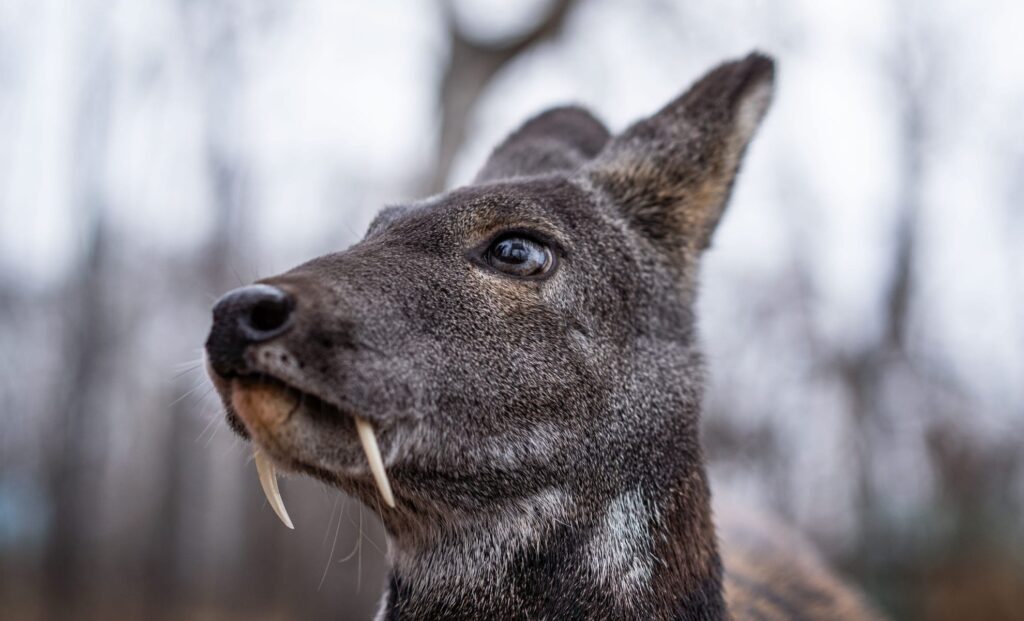Found in parts of Asia and, oddly enough, the British countryside, these deer are part of a bizarre and little-known evolutionary path. Despite their appearance, they pose no threat to humans and play a crucial role in their native ecosystems.
Contrary to common perception, antlers are not a universal feature among deer. Several species, especially those grouped under the loose label of “vampire deer,” have evolved without them. Instead, males grow tusk-like upper canines that can reach up to 10 centimeters in length. These tusks are not used for hunting or feeding—they are tools for sparring and self-defense, much like antlers in other species. The Chinese water deer and the musk deer are among the most recognizable of these fanged deer.
These animals, though rarely spotlighted, are facing increasing threats from habitat loss and commercial hunting. As traditional medicine continues to demand musk, and as urban development encroaches on their territory, several populations are now classified as vulnerable or endangered.
Tusks Instead of Wood for Defense, Not Blood
Among the deer classified as “vampire” species, the Chinese water deer (Hydropotes inermis) and various types of musk deer (Moschus spp.) are the most striking. Both males of these species lack antlers, a rare trait in the deer family, and instead develop sharp, curved tusks. According to ZME Science, these tusks can reach up to 10 cm and are primarily used during mating season as weapons in fights between males.
Unlike traditional deer found in Europe or North America, these species rely heavily on stealth and terrain navigation rather than size or strength. The musk deer, for instance, are agile jumpers, adapted to steep and uneven landscapes in the Himalayas and Siberia. They rely on acute hearing to detect threats, while the Chinese water deer prefer wetlands and can swim long distances to escape predators or search for shelter.
Both species exhibit behaviors related to territoriality: water deer males mark their range with dung piles and scent their surroundings by rubbing their foreheads on trees—even though they lack scent glands. When alarmed, they emit a bark and a high-pitched shriek, creating a surprisingly dramatic presence for such a small animal.

A Rare Conservation Twist
The Chinese water deer has one of the more unexpected conservation stories in recent history. In the late 19th century, Herbrand Russell, the 11th Duke of Bedford, imported several specimens from China to his estate in England. This decision, which might have seemed eccentric at the time, later proved vital to the species’ survival.
At one point, the Chinese water deer population had vanished from China, and the only surviving group lived in the UK. The escaped population went on to establish itself in the English countryside, where it is now sometimes hunted for sport. Though the species remains listed as “vulnerable,” the UK population helped prevent its total extinction.
The adaptability of these deer has also led to their presence in Argentina and parts of the United States. In France, a small feral population was introduced but is now presumed extinct, with no sightings reported since 2000. Their survival across such diverse environments underscores a remarkable resilience—but also highlights how closely intertwined human decisions are with species preservation.


Musk Trade and Poaching Threats
The musk deer, native to forested and alpine scrub regions in Southern Asia, are particularly at risk due to the demand for musk—a waxy, pungent substance produced by a gland in the abdomen of males. Musk is highly valued in traditional East Asian medicine and is also used in cosmetics, detergents, and perfumes. Musk is believed to help with ailments affecting the heart, nerves, and respiratory system.
Despite the possibility of extracting musk from live animals, commercial practices often involve trapping and killing the deer, including females and juveniles that do not even possess the musk gland. This method has contributed to a dramatic decline in population numbers. All musk deer species are now listed under CITES Appendices I and II, which indicates a high risk of extinction and enforces strict trade restrictions.
The illegal wildlife trade continues to target these deer, with poaching exacerbating the pressures of habitat destruction caused by agricultural expansion and severe weather events linked to climate change. In South Korea, where predators like tigers and leopards have been extinct for decades, water deer populations have flourished to the point where they’re now classified as “harmful wildlife,” due to their impact on crops and ecosystems.

